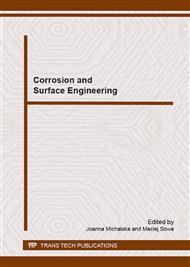p.23
p.27
p.31
p.35
p.39
p.43
p.47
p.51
p.55
The Corrosion Processes Effect on Surface Roughness of Bonded Magnetic Material Based on Nd-(Fe,Co)-B Powder Type
Abstract:
This paper presents an analysis of the Nd-(Fe,Co)-B bonded magnetic materials surface before and after corrosion tests. In the technological process of bonded magnetic materials the main difficulty is the fact that in the presence of small amounts of oxygen magnetic powders (having in their composition a highly active, a rare earth element) the particle surface easily cover with an oxide layer. The oxides phases are creating and furthermore the presence of this kind of paramagnetic phase on the powder particles surface adversely affects on the properties of the final product. Important is to protect the surface against spontaneously oxidation of the magnetic materials. One of the activities way to surface isolation is creating the additional protection coating (biencapsulation). Biencapsulation is a protection process in which not only set resin layer, but also an additional protective coating has been applied. The powder particles are coated with protective coatings: Ni-P/epoxy resin and phosphate/epoxy resin. In the paper the roughness measurement (2D) with profilometer (Taylor Hobson) results were presented. Also the effect of corrosion process evaluation on the bonded magnets surface roughness were determined (sulfate solution pH = 3, the exposure time 4h). It has been found that the application of powder particles biencapsulation with phosphate/epoxy resin coating (in comparison with Ni-P/epoxy resin biencapsulation) leads to a more effective corrosion protection of the final bonded magnets.
Info:
Periodical:
Pages:
39-42
Citation:
Online since:
January 2015
Authors:
Keywords:
Price:
Сopyright:
© 2015 Trans Tech Publications Ltd. All Rights Reserved
Share:
Citation:


